Route signs located in railwaystation, Villa Koivuniemi, Vilppulankoski rapids, marina, 1918 monuments and Vilppula church. Along the route you can also visit the Vilppula Tradition Room, the Local Museum and the School Museum.
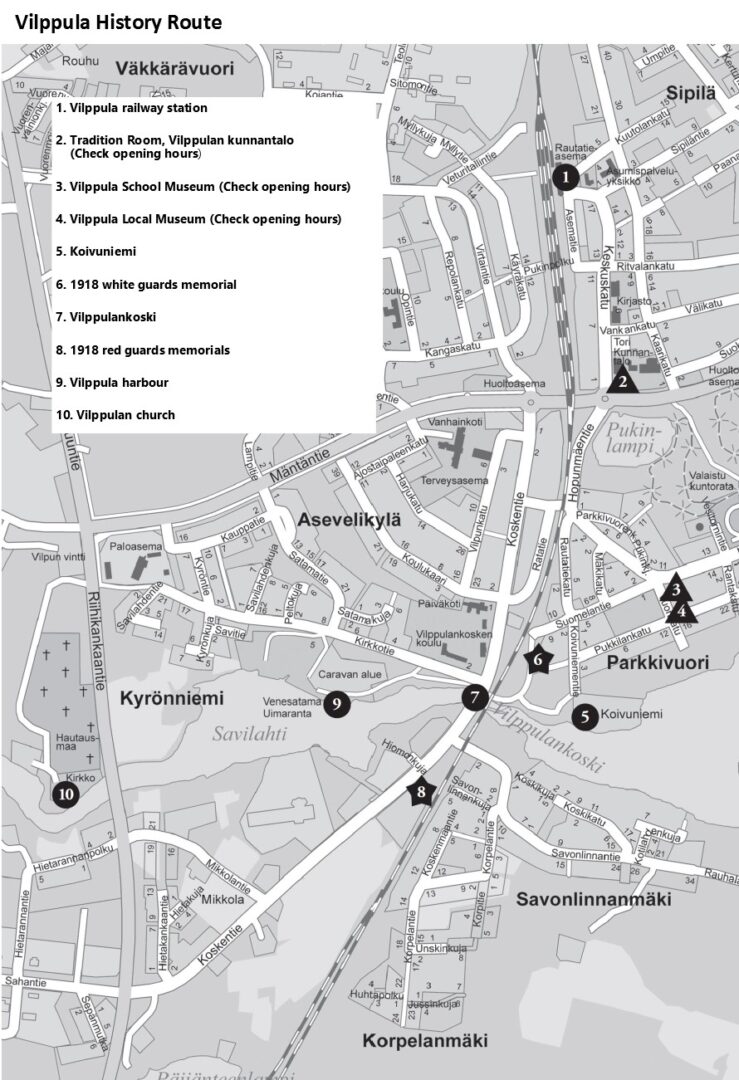
Printable map of the History Route
Sights of Vilppula history route on Google maps (to be completed)
The general history of the route has been compiled by researcher Tarja Antikainen and the military history sections by historian Tuomas Hoppu. The Serlachius Museums and Vilppula-Seura have helped to gather the local history data and photographs. The route signs have been produced by the town of Mänttä-Vilppula in co-operation with Civil War Museum association.
1. The Vilppula railway station | 1918
The building of the Finnish railway system began in the 1860s. The Tampere-Vaasa line, or the Ostrobothnia line, was built between 1879 and 1883. The decision to run the line on the eastern side of Lake Näsijärvi was heavily influenced by G.A. Serlachius, the owner of the Mänttä mill. Serlachius constructed a narrow-gauge industrial train line between Vilppula and Mänttä in 1897. The train line was in use until the 1930s, when the standard-gauge line built by the state reached Mänttä.
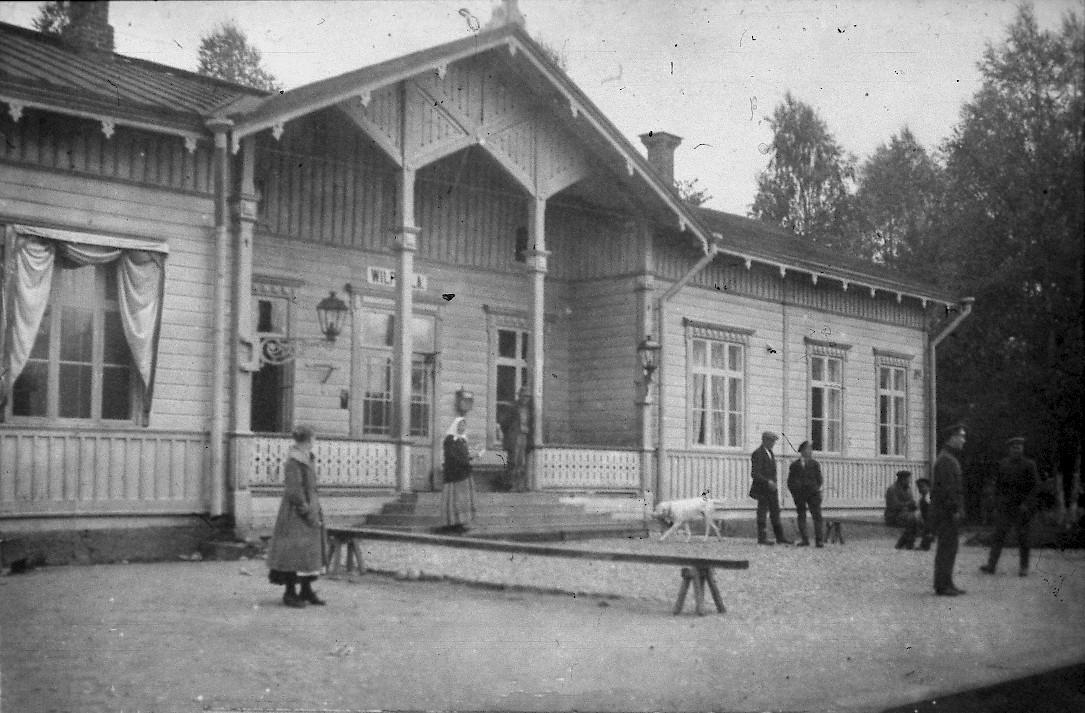
Picture from Vilppula-Seura ry.
The railway construction brought railway builders to Vilppula and also created jobs for the locals. Vilppula rose in affluence as a result, and cottages and farms were built along the railway. Sometimes the railway construction crew caused disorder, and drunkenness was not unheard of.
The national railway network had its own construction and planning organisation from the 1870s onwards. The Vilppula railway station was a category IV rural railway stop and its current appearance is based on the 1903 extension design by architect Bruno Granholm. The architectural designs were created by civil servant building designers and was therefore anonymous, but railway construction served as a channel for spreading architectural influence in the 19th and 20th century. The station milieu was important, and it was well maintained as the railway brought added value to the locality. The station garden was usually the first public park of a town or village.
The railway has also played a key role in industrialisation, dissemination of education and the development of postal services. People, goods and ideas could move much faster and much further than before. People gathered at the station to greet the train and the first major commercial activities were established near the station.
The station and its surroundings in Vilppula became an important hub for transport, social life and communications.
The warehouses of the Mänttä and Jämsänkoski paper mills were located at Vilppula station until the 1930s. The operations were at their height at that time as goods were being loaded and unloaded. Passengers changed from the narrow-gauge railway onto trains heading towards Tampere and Vaasa. Once the standard-gauge railway was completed in the 1930s, and up until the 1950s, the passenger traffic between Vilppula and Mänttä was conducted by the railcar “Mäntän Motti”.
Today, the stations at Vilppula and Kolho are included in the National Board of Antiquities’ inventory of cultural heritage sites of national significance.
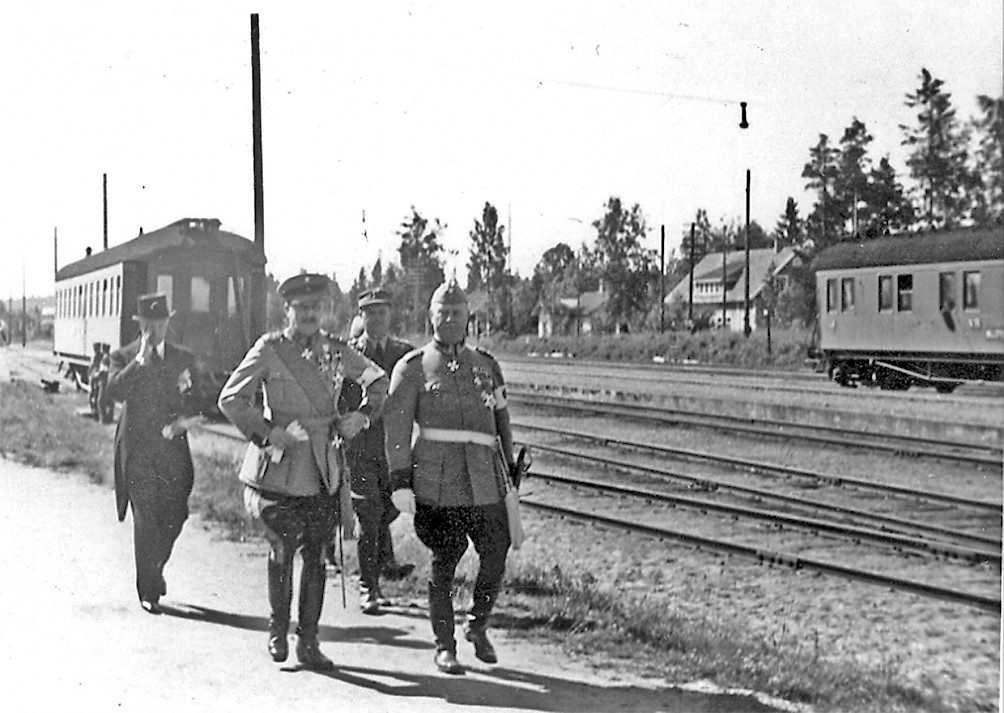
Gösta Serlachius Fine Arts Foundation, Serlachius Museums, picture archives.
1918
In 1918, Finland experienced a brutal civil war, which lasted for four months and resulted in the loss of nearly 40,000 lives. For seven weeks from the first days of the war, Vilppula was the centre of events. The northern side of Vilppulankoski was held by the White Guard and the southern side by the Red Guard. The Finnish Civil War ended on 16 May 1918 with the victory of the White Guard and the defeat of the Red Guard. The White Guard was led by the Finnish Senate and the Red Guard by the Finnish People’s Delegation that opposed the Senate.
The White Guard troops from Ostrobothnia took command of the Vilppula railway station as soon as the Civil War began. The station and its environs served as a significant base for supplying the White Guard troops in the region of Vilppula and Ruovesi. On 3 February 1918, a mass was led by Rev. Väinö Malmivaara from Lapua; it is considered to be the first-ever military church service held in Finland.
In the early stages of the Vilppula campaigns, the White Guard also placed artillery near the station building, but on 7 February, the artillery were moved further next to the railway line. The Red Guard attempted to hit the station area with artillery fire, a strike that caused very little damage.
Vilppula Railway Station area was one of the first locations in Finland ever to be attacked from air. The Red Guard planes tried on several occasions to drop bombs on the railway yard but will little success.
The Kuutola building next door to the station building served as the mess hall of the officers and army service personnel. The station area also served as the command centre for the White Guard. On 15 February 1918, Colonel Martin Wetzer, commander of the Vilppula front, arrived at Vilppula Station from Haapamäki. He spent one month during the Vilppula campaign living in a railway carriage. On 18 February 1918, General Mannerheim, the military leader of the White Guard, also paid a visit to Vilppula. He returned to Vilppula in mid-March, when the Tampere operation of the Whites had commenced.
Towards the end of the Vilppula campaign, the Reds attempted to send a so-called “ghost train” to Vilppula Station. This was a train loaded with explosives, a move intended to cause destruction and disarray among the White Guard troops. The train made it across the Vilppulankoski railway bridge but was subsequently derailed. The railway workers arriving at the scene managed to lower the pressure in the engine and thus avoid the fatal explosion.
After 17 March, the front moved as a result of the White offensive towards the south, but Vilppula Station remained a crucial hub for the remainder of the war.
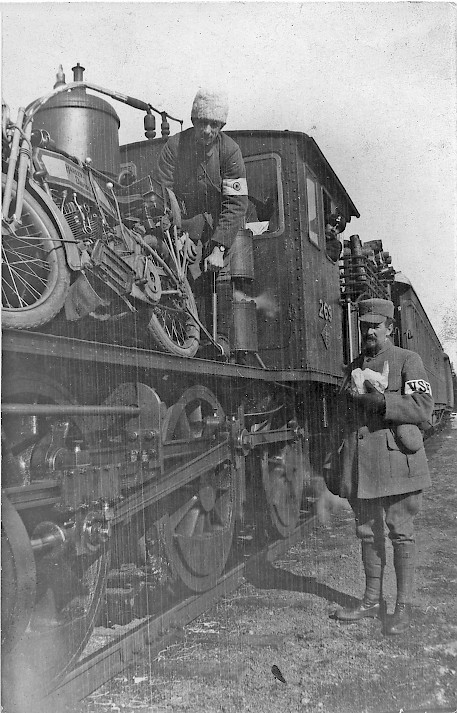
Picture from Military Museum of Finland.
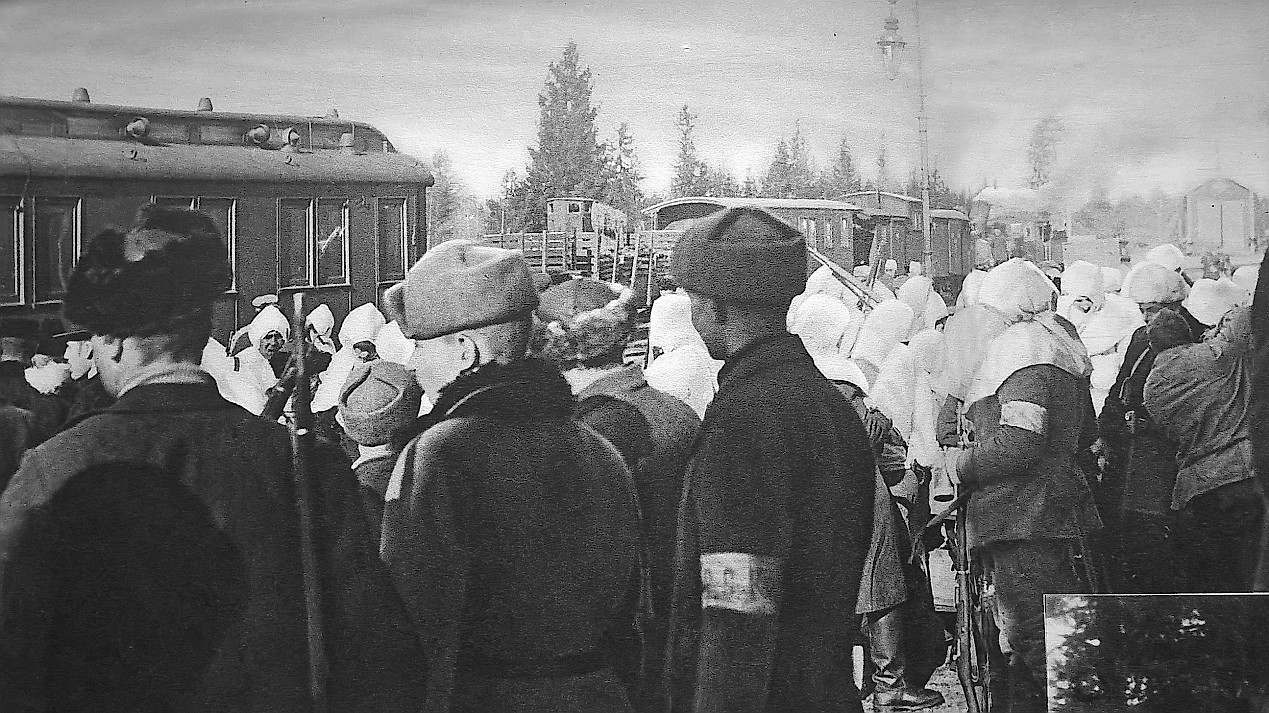
Picture from the book Suomen vapaussota kuvissa I–II (Finnish Civil War in Pictures I–II).
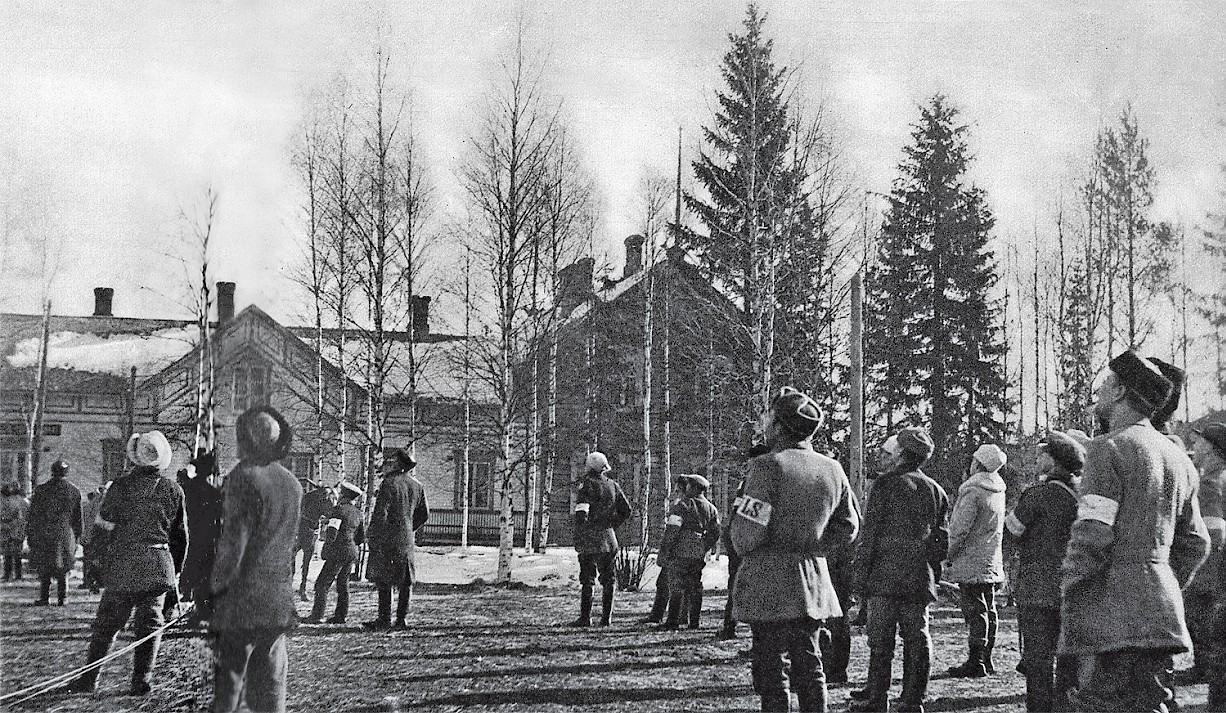
Picture from the book Suomen vapaussota kuvissa I–II (The Finnish Civil War in Pictures I–II).
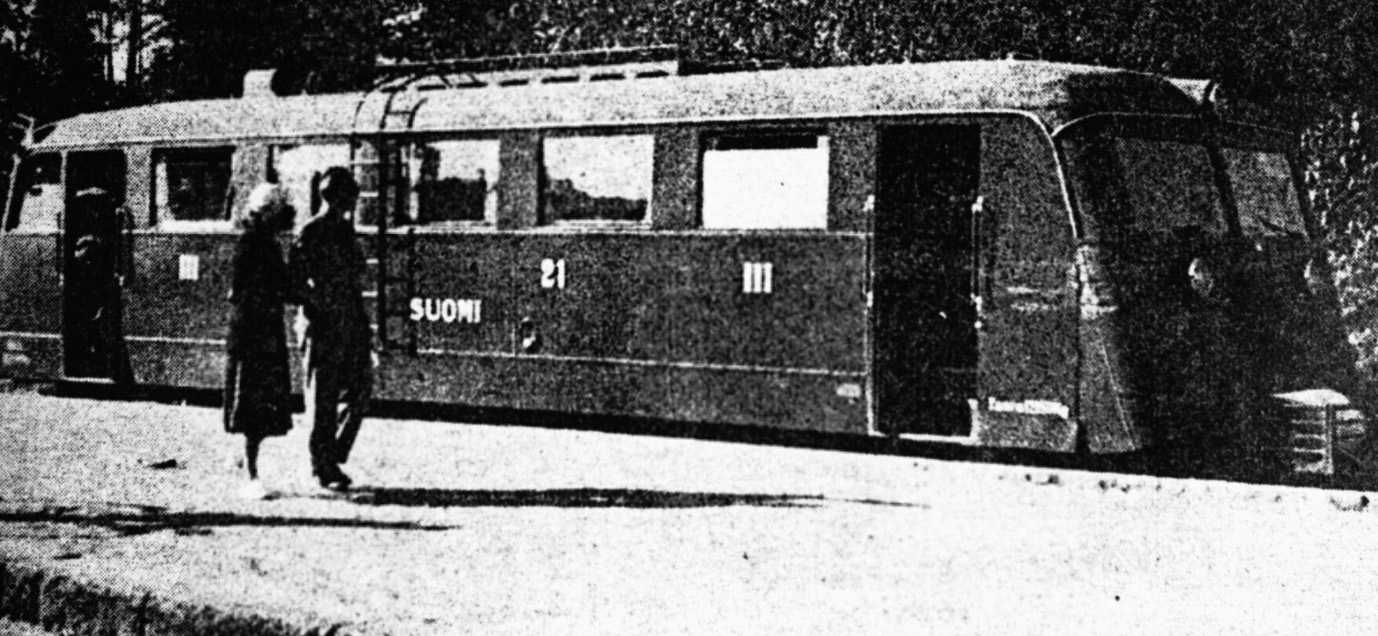
Gösta Serlachius Fine Arts Foundation, Serlachius Museums, picture archives.
2. Vilppula Tradition Room
The tradition room’s collection will be moved and will later be on display at Vuorikatu 1, Vilppula.
Managed by the Vilppula-Seura ry. In addition to the tradition room, there is also a school museum and a local museum.
3.-4. Vilppula local museum and school museum
In the local museum are displayed local objects related to the rural life as well as fire pumps and items related to the Finnish railway service company.
The school museum displays objects related to school education in the olden days.
The museums are open in July and at other times by arrangement.
Vuorikatu 1, Vilppula
www.vilppulaseura.fi
5. Koivuniemi | 1918
Life in the Vilppula region sprang to new life with the arrival of the railway network, to the extent that in 1880, Adolf Aminoff, the owner of Pekkala Manor in Ruovesi, together with Danish master brewer Fredrik Karl Christian Bär, decided to establish a brewery upstream from Vilppulankoski, on a farm called Peltoniemi.
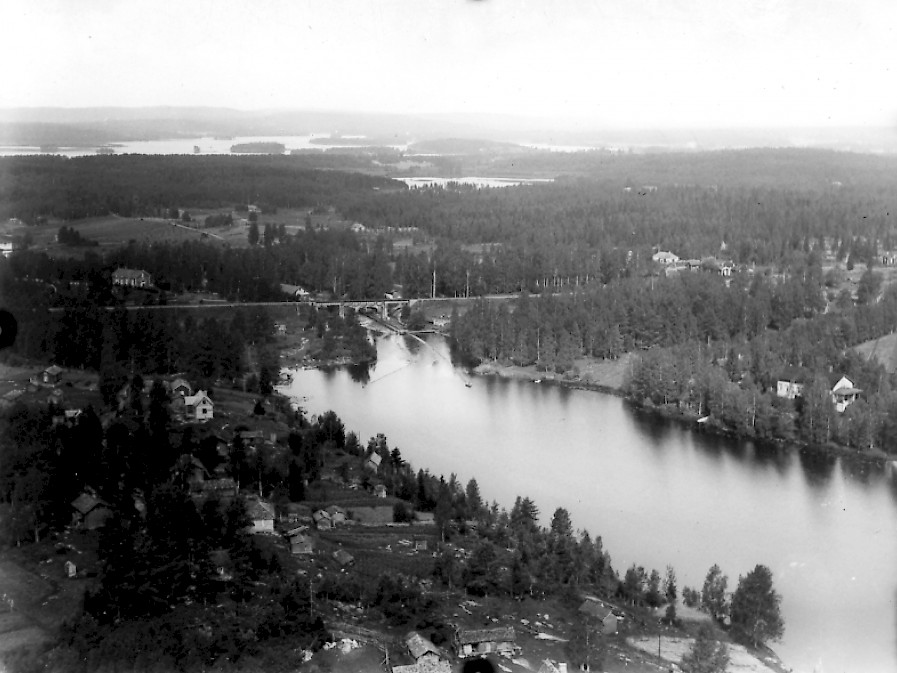
Picture from Vilppula-Seura ry.
VILPPULA BREWERY
After six months of building work, the two-storey brewery and a separate stone cellar were complete. Master brewer Bär moved in to live in a building built next door to the brewery, and the brewery started operations in February 1882. Soon after, in November of the same year, Bär died, and his position was taken by Otto Silverberg from Ostrobothnia.
The products of the brewery were sold widely in the Vilppula region, as far as in Murole. The sales were organised through shopkeepers, millers, farmers and farm hands.
The brewery building burnt down in 1884, and was not replaced, so the history of the brewery turned out to be short-lived. The stone foundations of the brewery can still be seen in the yard at Koivuniemi.
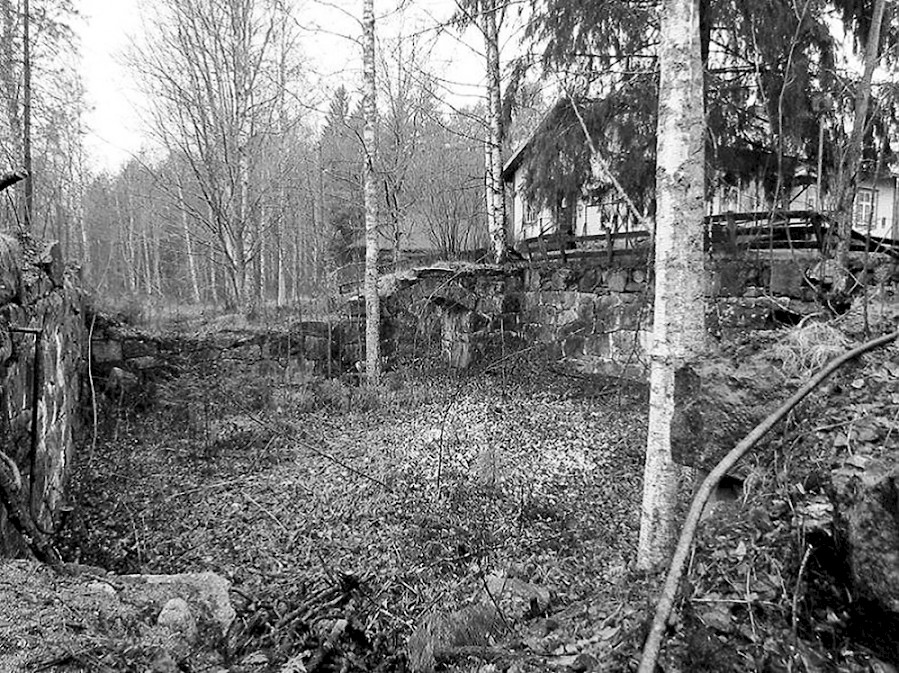
FROM KLAMINNIEMI TO KOIVUNIEMI
Following the death the Adolf Aminoff in 1888, the leasehold and the buildings of Koivuniemi were bought by Aksel Matias Jaatinen, a judge of the Ruovesi district court, from the bankruptcy sale by auction of the estate. According to the inventory, the buildings comprised the main building, a smithy, a barn, a cowshed, a cellar and a smaller residential building. Its current form, the Koivuniemi main building, was acquired during Jaatinen’s ownership in the 1890s.
After Tuomas Jaatinen’s death in 1907, Koivuniemi came under Wäinö Jaatinen and, after his death,
Armia Jansson, a lawyer’s widower. Koivuniemi became the centre of cultural life in Vilppula. In 1919–1952, Koivuniemi was the home of the district physician Väinö Klami, who also held his surgery in the house. At that time, the estate was renamed “Klaminniemi”. Local authorities purchased Koivuniemi in 1969 and refurbished the building to serve as an adult education centre in 1987.
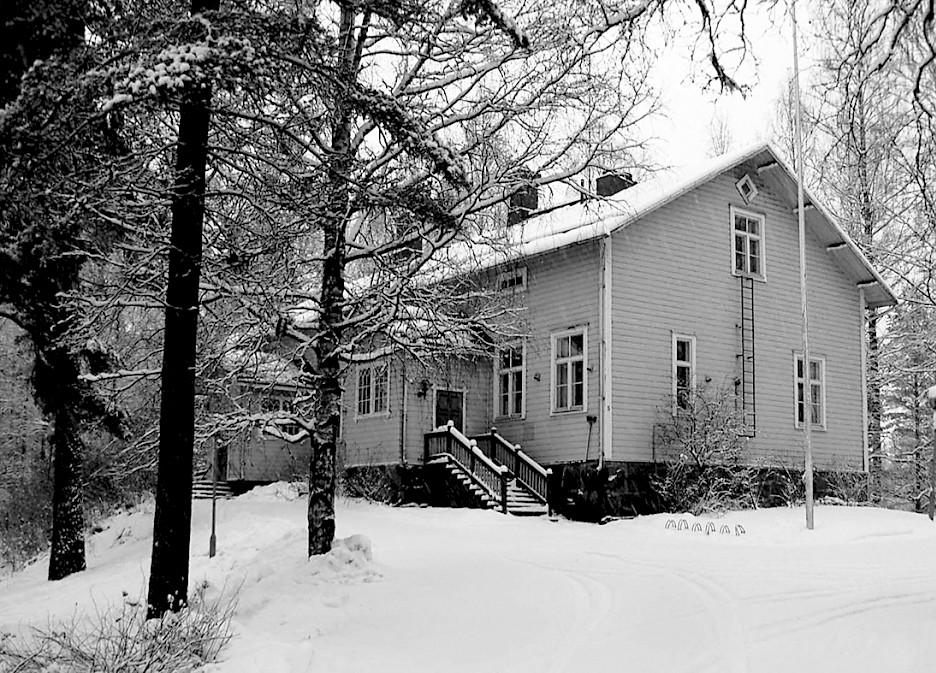
1918
In 1918, Finland experienced a brutal civil war, which lasted for four months and resulted in the loss of nearly 40,000 lives. For seven weeks from the first days of the war, Vilppula was the centre of events. The northern side of Vilppulankoski was held by the White Guard and the southern side by the Red Guard. The Finnish Civil War ended on 16 May 1918 with the victory of the White Guard and the defeat of the Red Guard. The White Guard was led by the Finnish Senate and the Red Guard by the Finnish People’s Delegation that opposed the Senate.
During the battles of Vilppula, which lasted from the beginning of February to mid-March 1918, Koivuniemi fell within the part of the front line held by the White Guard.
Following the first hostilities, the Whites extended their defence line reaching Koivuniemi.
Like many other houses in Vilppula, Kouvuniemi was used by White Guard soldiers as a place to sleep. Sheltered by Vilppulankoski rapids, Koivuniemi was not, however, under immediate risk of being attacked. The Red Guard could only attempt to cross the rapids along the bridges and they never managed to advance across through the railway or road bridge.
6. White guard memorial | 1918
In 1918, Finland experienced a brutal civil war, which lasted for four months and resulted in the loss of nearly 40,000 lives. For seven weeks from the first days of the war, Vilppula was the centre of events. The northern side of Vilppulankoski was held by the White Guard and the southern side by the Red Guard. The Finnish Civil War ended on 16 May 1918 with the victory of the White army and the defeat of the Reds. The White Guards were led by the Finnish Senate and the Red Guards by the Finnish People’s Delegation that opposed the Senate.
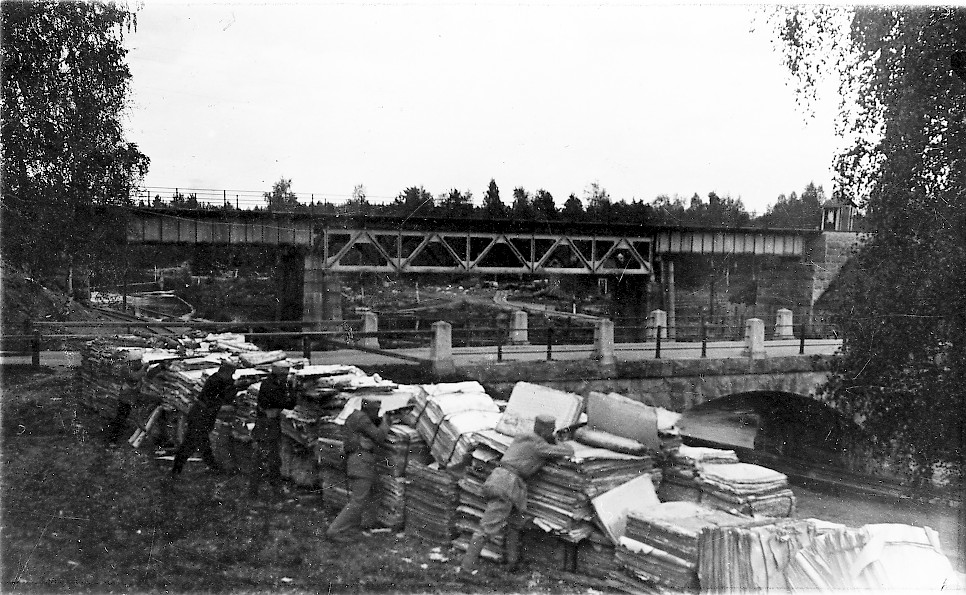
A clear divide between the White and Red front lines formed in the early stages of the war, in January and February. Maintaining control over Vilppula was a key objective for the Whites, as the Vilppula troops offered protection for the crucial railway intersection at Haapamäki.
Several campaigns were fought over the control of Vilppula, in which the White troops, despite being few in number, managed to fend off the Red forces. As a result, on the side of the Whites, the name Vilppula name has always been associated with great sacrifice and bravery. Vilppula was seen as the stronghold that stopped the Red army’s advance towards the north. Professor Heikki Klemetti composed the song “In Memory of the Vilppula Heroes”, which, for a long time, was a staple in school song books.
The Vilppula front extended in early February to Ruovesi, where the battles eventually turned much fiercer than in Vilppula. Approximately sixty White Guard fighters were killed in action in Vilppula and Ruovesi between the beginning of the war and the Battle of Tampere. Most of them were killed in the Battle of Ruovesi. The Whites killed in action were taken to their home parishes to be buried.
The year 1918 brought Vilppula into the national consciousness more than ever before or since. To commemorate the events at Vilppula, the White veterans launched a fundraiser in 1932 for a memorial. The funds were used for organising a design competition.
The original idea was to erect the White Guard memorial in Vilppulankoski rapids, but the plan proved infeasible, and the memorial was built on its current location. Financed by Gösta Serlachius and created by sculptor Arvi Tynys, the memorial was unveiled in July 1938. The ceremony was attended by General Gustaf Mannerheim, the leader of the White army, his staff and a large audience. Tynys was a renowned artist who, in addition to Finland, made a notable career in the United States and Haiti.
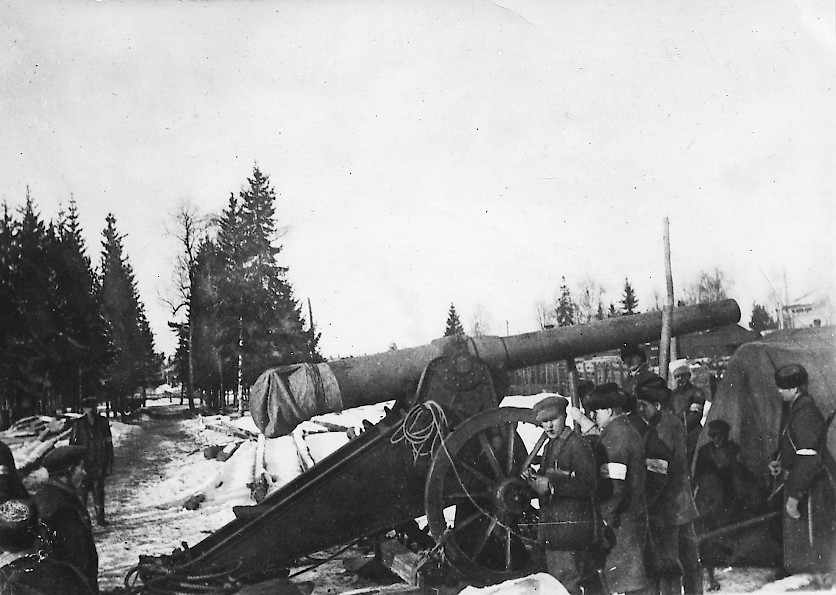
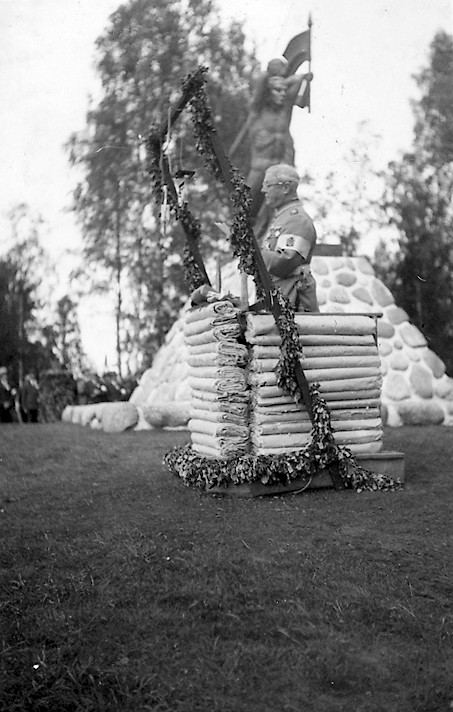
Gösta Serlachius Fine Arts Foundation, Serlachius Museums, picture archives.
7. Vilppulankoski | 1918
BRIDGES OF VILPPULANKOSKI
During the Famine of 1866–1868, a number of roads were built in Finland as emergency public works. The building of the Ruovesi–Vilppula road began in 1863. The Vilppula–Juupajoki–Orivesi road was completed in 1868. In summer 1876, a wooden bridge was constructed in Vilppulankoski and it remained in use until the turn of the 20th century. The old wooden bridge was a popular meeting place for young people in the village. A new stone bridge was built in its place in 1901.
The bridge was constructed under K.G. Reipas, a famous stone builder of the time. The transport and delivery of stones required special equipment, including hoists and chains, a piling crane and an iron winch. The railway bridge was also reinforced in 1910–1911, as engines had grown heavier and railway traffic more frequent on the Tampere–Vaasa line by the turn of the 20th century.
With the building of the groundwood mill in Vilppula, bridges to serve industrial transport needs were also built across the rapids. Groundwood were transported on rails across the rapids and similarly the rolls of ground pulp would be transported back onto the northern shore, from where they continued their journey along the narrow gauge railway line to the Vilppula railway station and onwards to the paper mill in Mänttä. There were separate tracks next to the road bridge for these manually pushed pulp carriages.
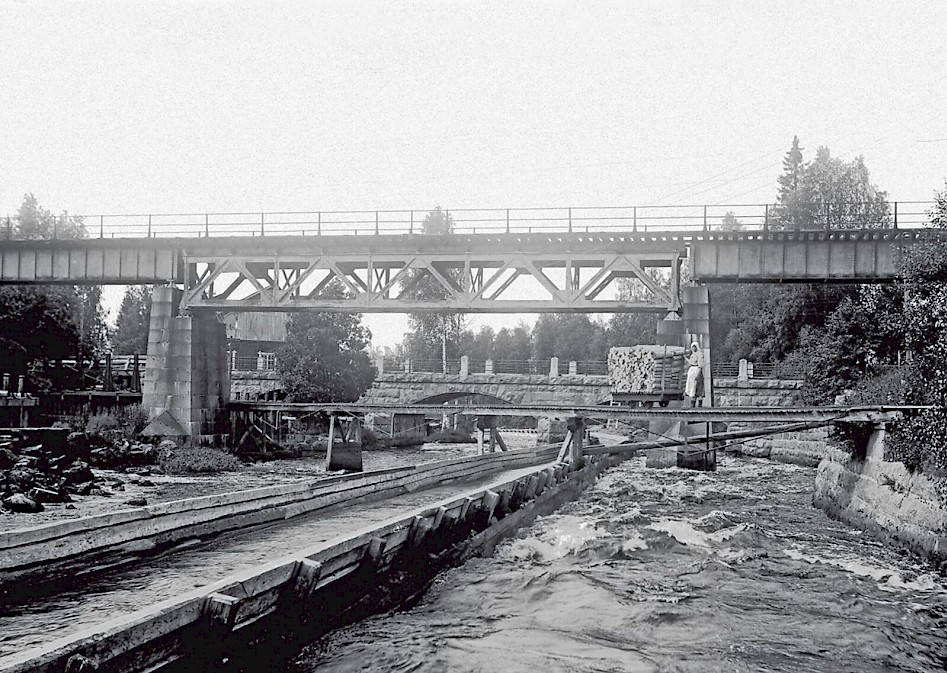
Gösta Serlachius Fine Arts Foundation, Serlachius Museums, picture archives.
VILPPULANKOSKI GROUNDWOOD MILL
A total of 12 new groundwood mills were launched throughout Finland between 1865 and 1875 on the shores of suitable rapids. At first, aspen was used, but soon the peeled spruce bolts replaced it as the raw material. Groundwood mills had high fire risk and many of them burnt down during their first few decades.
From the 1880s onwards, groundwood mills were usually built of brick and acquired the appearance of a proper industrial building.
The groundwood mill in Mänttä had started operations in 1869, but the ground pulp it produced was not able to meet the demands of the paper mill completed in the 1880s on its own. Factory owner G.A. Serlachius built the second groundwood mill by Vilppulankoski in 1882. Soon after, in 1888, the building was destroyed in a fire but was immediately rebuilt.
The Vilppula groundwood mill was a simple, red-ochre log building resembling a traditional grain mill. The machinery was situated in a two-storey building so that the process could unfold from top to bottom, making use of gravity. On the bottom level of the building were the turbines, which mechanically, by way of cogwheels, shafts and belts powered the machines. In addition, a 75 horse-power vertical-shaft Jonval turbine was directed, coupled with the grinders. A third, smaller turbine powered the ancillary machines and dynamo lights.
The 60 cm peeled spruce logs were pressed with water against the circulating grinding stone. The liquid pulp was led from the grinders along wooden flumes through a number of sieves to the collector, where it formed sheets around metal rollers. The sheets were folded like fabric into rolls and placed on the pushcart, in which they were taken across the rapids and from there on along the narrow gauge tracks towards the Mänttä paper mill.
The factory employed between 10 and 20 workers. The longest-serving director was Adolf Leander, who had previously served as a foreman at the Mänttä paper mill. The factory operated in three shifts – four on each shift. Adolf Leander lived in the office building and the director’s residence on the western side of the mill. Right next to the mill, between the tracks and the road, was the residential building for factory workers, with six dwellings, each comprising one room and a kitchen. Some of the workers lives in their small cottages on the eastern side of the tracks in Savonlinnanmäki.
After 63 years of service, the Vilppula groundwood mill was closed on 10 June 1945. The building was demolished and its machinery was scrapped. The memorial for Vilppula groundwood mill, made from two grinder stones and a turbine runner was erected in 1990s on the initiative of Kaarina Pollari, a noted local history activist.
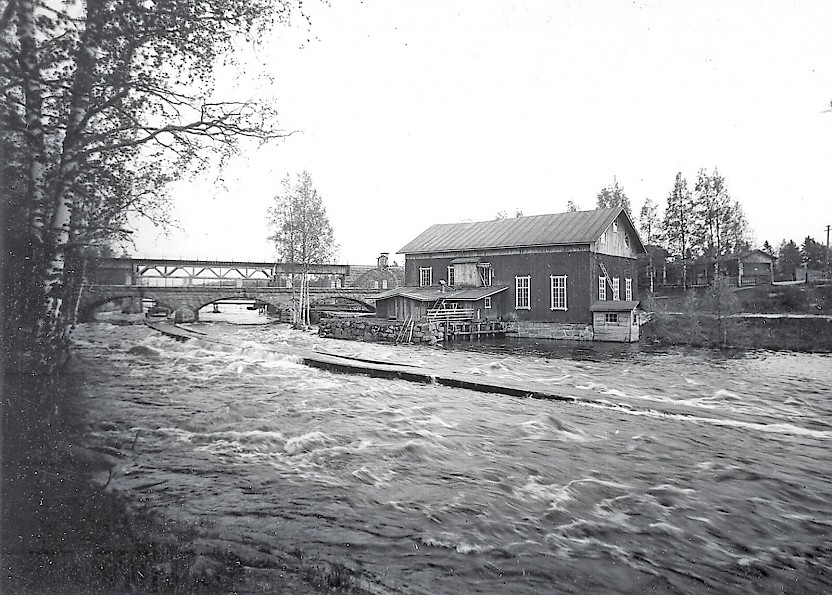
Gösta Serlachius Fine Arts Foundation, Serlachius Museums, picture archives.
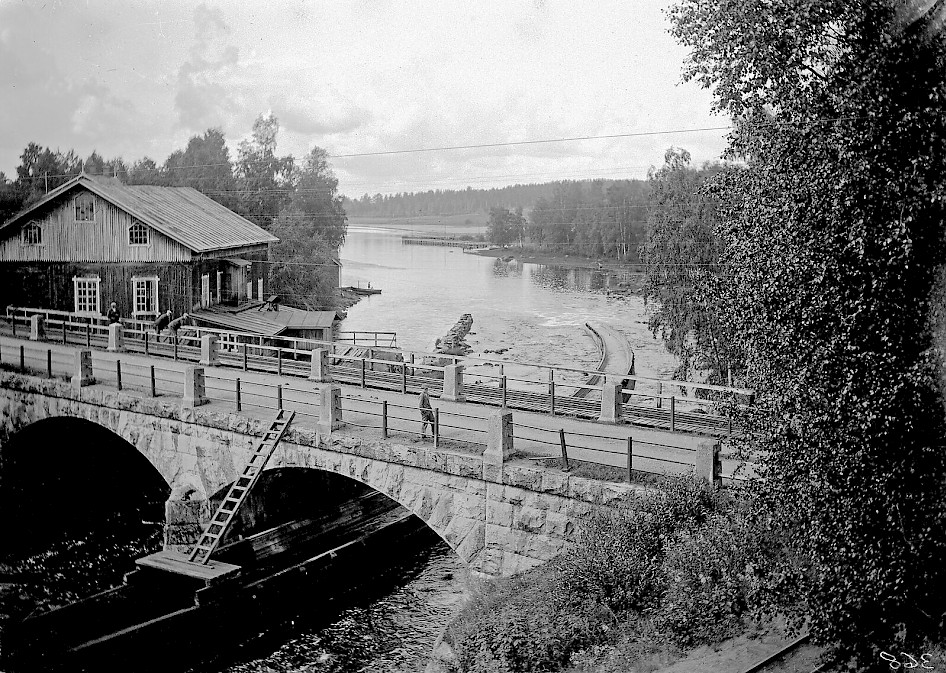
Gösta Serlachius Fine Arts Foundation, Serlachius Museums, picture archives.
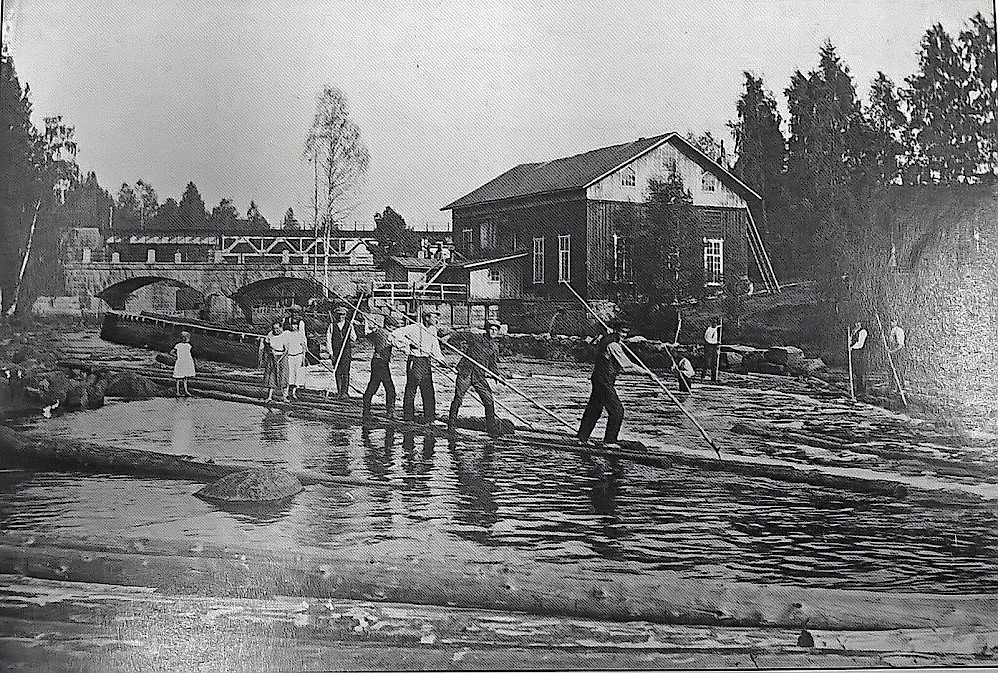
Picture from Vilppulan ja Pohjaslahden historia (The history of Vilppula and Pohjaslahti).
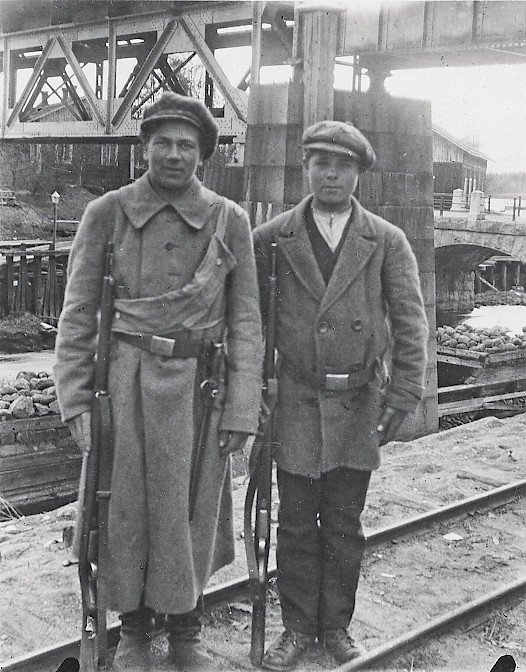
Picture from Military Museum of Finland.
1918
In 1918, Finland experienced a brutal civil war, which lasted for four months and resulted in the loss of nearly 40,000 lives. For seven weeks from the first days of the war, Vilppula was the centre of events. The northern side of Vilppulankoski was held by the White Guard and the southern side by the Red Guard. The Finnish Civil War ended on 16 May 1918 with the victory of the White army and the defeat of the Reds. The White Guards were led by the Finnish Senate and the Red Guards by the Finnish People’s Delegation that opposed the Senate.
In the course of January and February 1918, Vilppulankoski became part of the frontline between Red Finland and White Finland. Vilppula was occupied on 1 February 1918 by Ostrobothnian White Guard troops. The Reds, supported by Russian troops, attempted to proceed along the railway line to assist Russian garrisons in Ostrobothnia. Later, the main objective of the Reds was to take over the strategically important Haapamäki railway station.
White Guard troops had settled in Vilppula, as the rapids were deemed to offer an advantageous defence position. The rapids did not freeze in the winter, and with only three crossings – the road bridge, the railway bridge and a turnbridge near the church – effectively stopped the enemy.
To add further obstacles for crossing the rapids, the Whites opened the Mäntänkoski dam, which caused ice to break all the way up to Kirkkosalmi.
The focus of the White Guard defence was on the railway line, which the enemy attempted to use to advance. In early February, the White Guard set up two machine guns on the northern side of the railway bridge, protected by bales of pulp from the Mänttä mill. During the first offensives on 2, 4 and 7 February 2018, the White Guard defended themselves from these positions behind the rapids, primarily with machine guns and artillery. The Reds never advanced to the rapids. After mid-February, the focus of the offensive on the Vilppula front moved on to Ruovesi and the White Guard moved its front line two hundred meters south of Vilppulankoski.
The last event of the Civil War to take place in the environs of Vilppulankoski was the attempted offensive by the Reds on 13 March 1918. Four days later, the White Guard began its own offensive in Vilppula as part of the operation to take over Tampere. After this, the frontline was moved away from Vilppula.
8. Red guard memorials | 1918
In 1918, Finland experienced a brutal civil war, which lasted for four months and resulted in the loss of nearly 40,000 lives. For seven weeks from the first days of the war, Vilppula was the centre of events. The northern side of Vilppulankoski was held by the White Guard and the southern side by the Red Guard. The Finnish Civil War ended on 16 May 1918 with the victory of the White Guard and the defeat of the Red Guard. The White Guard was led by the Finnish Senate and the Red Guard by the Finnish People’s Delegation that opposed the Senate.
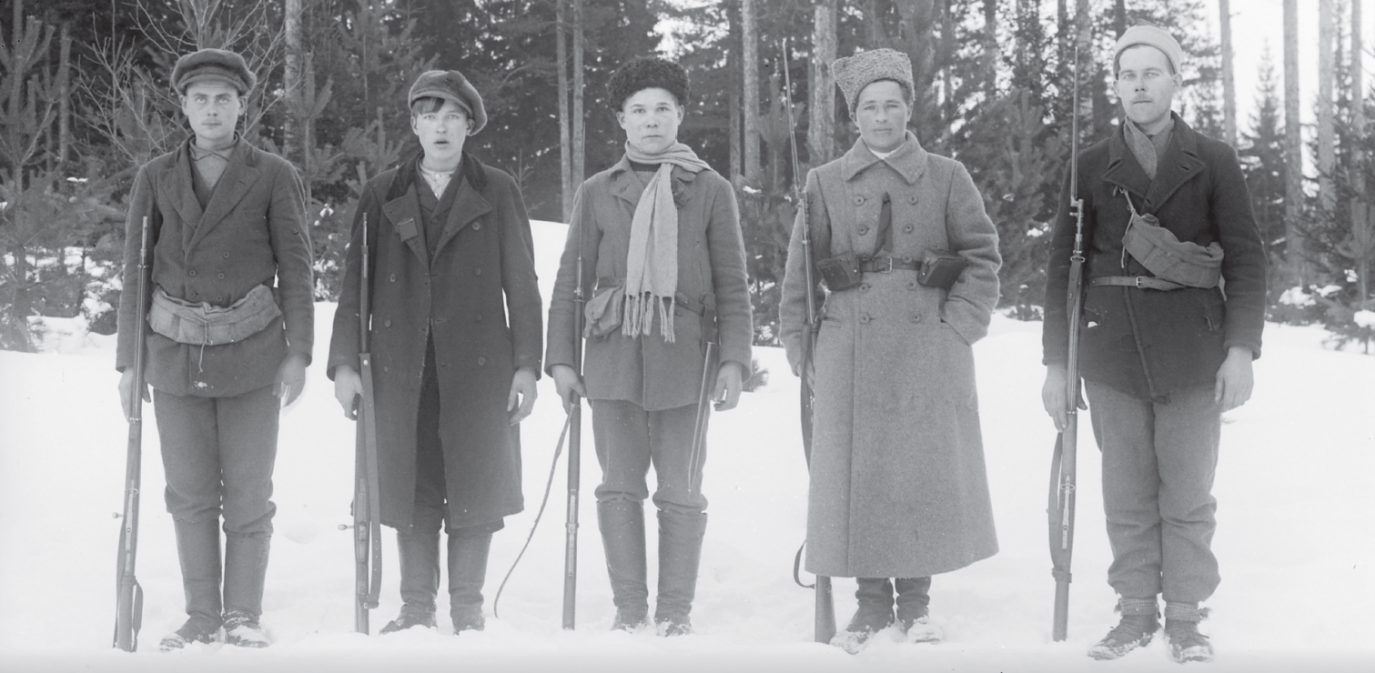
Vapriikki Photo Archives.
In 1918, there was a 200–300 strong Red Guard in Vilppula that consisted of separate sections in villages throughout the parish. After the war broke out, the majority of the Vilppula Red Guard set out to take over Mänttä.
Some of the Red Guard members stayed home and took no part in the hostilities. After the failed attempt to take Mänttä and with their own parish under the control of the White, the Vilppula Red Guard took part in the battles of Vilppula in February and March of 1918. For them, the fiercest battle, however, was fought defending Tampere against the Whites in March and April 1918. During the battle over Tampere, half a dozen Vilppula Red Guard fighters were killed. Most of the Vilppula Red Guard were taken prisoner on surrendering Tampere of 6 April 1918. In the aftermath of the Battle of Tampere, nearly 20 Red Guard soldiers from the Vilppula region were executed.
After World War II, memorials for the Reds perished in the Civil War began to be erected. There are two Red Guard memorials at Vilppula Cemetery, both erected in 1946 by the workers’ organisations of Vilppula and Mänttä. The remains of the 15 deceased killed in the Civil War lie in the lower joint grave and those of 16 in the upper grave. In 1994, the old memorial received an addition in a memorial revealed on the southern side of Vilppulankoski on the site where the Reds had launched their attack against Vilppula in February and March of 1918.
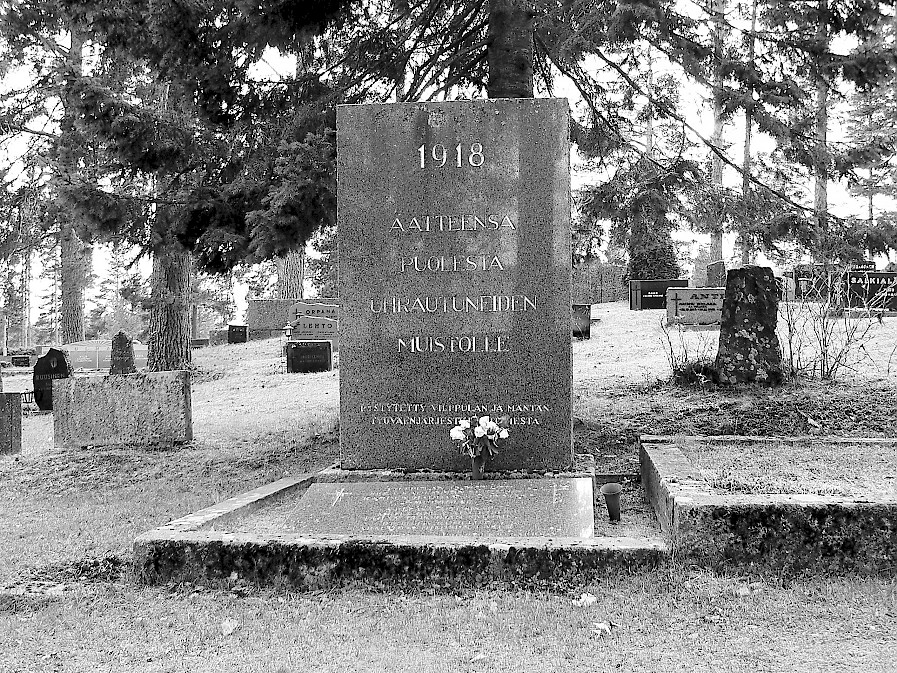
In 1994, an addition was made to the memorial , with the inscription: “In memory of the 31 deceased from Vilppula, Mänttä and further regions consigned to the two graves. Brother, father, mother, sister, look for us no longer, in this place we are laid down to rest. You who died on the cross have mercy on the children of men. Committal service conducted on 17 September 1994 by Bishop Yrjö Sariola”.
The Reds buried in Vilppula were either killed in action or executed by the Whites, both from Vilppula and from other localities. The total number of Vilppula Reds killed in action, by executions or at prison camps in the 1918 war is estimated at 80–90. A majority of them are buried elsewhere, mostly in Tampere.
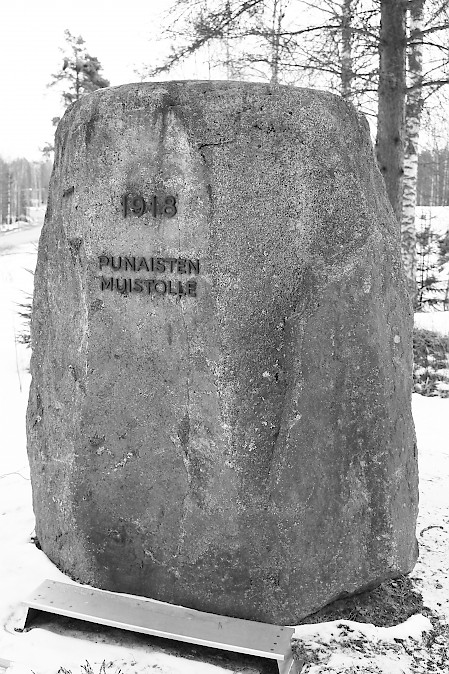
9. Vilppula harbour
Before the railway network, waterways were the most important transport routes between Vilppula, Ruovesi and Tampere. One of the routes, the Vilppu Route, operated from Vilppula to Ruovesi and onwards to Lake Näsijärvi. The signposted winter roads crossed the frozen lakes and narrow strips of land in between.
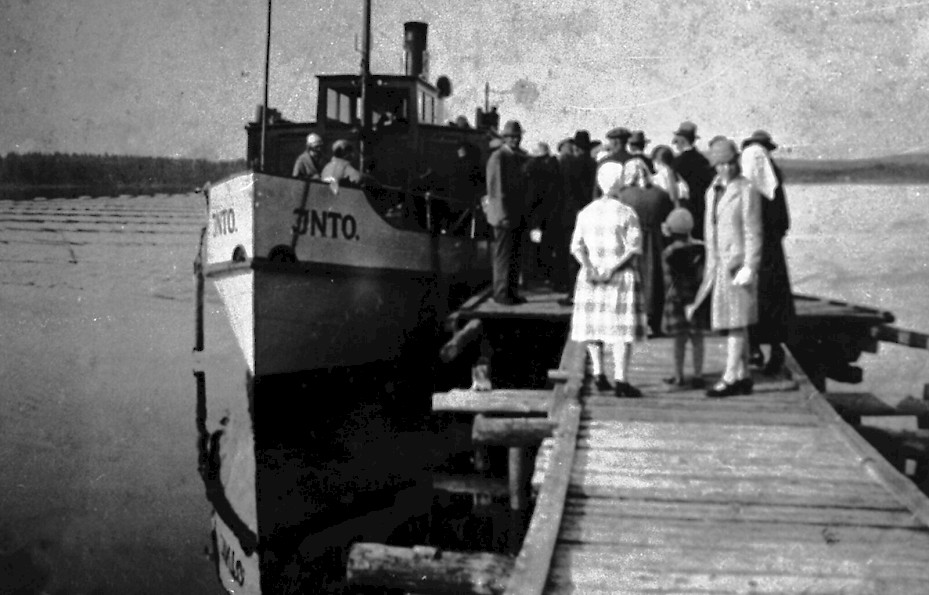
Gösta Serlachius Fine Arts Foundation, Serlachius Museums, picture archives.
STEAMBOATS ON THE GREAT LAKE ROUTES
Probably the first steam boat to travel below Vilppulankoski rapids was the galleass Jalo, which fetched a load of planks for Mänttä sawmill in June 1864. Galeasses Yökkö and Wilpas would carry logs to Tampere. Regular passenger traffic began in summer 1870, when steamship Toivo operated twice a week between Tampere and Vilppula, and at the end of the 1870s, two-deck passenger ship Mänttä also began operations. The boarding quays were located below the rapids in the boat harbour and near the church.
With the arrival of the railway, boat traffic died down for a period, until the early 1900s saw a revival of the lake boats, when the small-seized ship Kaima and Mänttä returned to operate the Vilppu Route. The ships even picked up passengers from tiny piers to take them to Ruovesi, where they would join larger ships to Tampere.
In 1907, the steamboat cooperative Tarjanne was established and it purchased S/S Into. The ship also carried goods and sometimes even cattle. At best, the journey from Vilppula to Ruovesi took only three-and-a-half hours. Into operated on the Vilppu Route until 1938.
TIMBER TRANSPORT
In addition to passenger ships, tugboats and small private steam boats were also a regular sight downstream from the rapids. Timber was floated from Keuruu waterways through Vilppulankoski all the way to the sawmills of Pori on the west coast of Finland. At its height, floats made up of thousands of logs were floating on the lake awaiting to pass through the rapids. In addition to saw and pulp wood, firewood stored below the rapids was also transported by water. Firewood was transported by barges, which were made in Vilppula and pulled by tugboats. Serlachius Oy built the last flat-bottomed barges below Vilppulankoski in 1938.
The boat harbour at Vilppulankoski is still very actively in use, but the low height of the Kirkkosalmi Bridge and the shallow passage mean that large ships can no longer moor in it and have to moor in the harbour at Mäkitalonlahti, which is maintained by the Vilppulan Veneilijät boating club.

Gösta Serlachius Fine Arts Foundation, Serlachius Museums, picture archives.
10. Vilppula church | 1918
The Vilppula region belonged to the parishes of Ruovesi and Keuruu in the 19th century. The long journeys to the church were made by long rowboats, “church boats” and in the winter crossing the ice over the lake. In 1890, a meeting was held at the house of Ala-Ajos, where it was decided that Vilppula should have its own chapel. A committee was established and collections were held. It was hoped that the chapel could be finished by the following year.
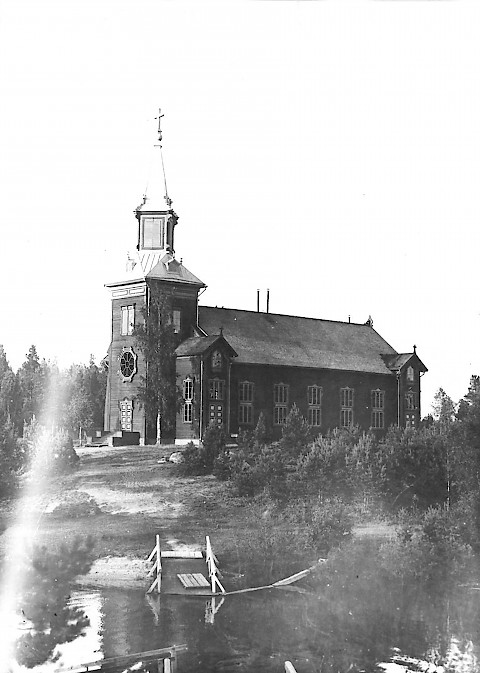
Picture from Vilppula-Seura ry.
There were many views as to where the chapel should be built, but finally the matter was decided as three hectares of land by Äijänsalmi strait was donated for the building of the church and a cemetery. An official society was established to oversee the project. A local craftsman, Juho Nieminen, was appointed as the project’s foreman and the building reached roof height in 1892. The first mass in the new church was held with people standing on floor fillers. The building project was finally completed close to the end of the century. The church was consecrated by Herman Råbergh, bishop of Porvoo, in September 1900. Vilppula gained its status as an independent parish in 1904.
The church was designed by architect Georg Schrek. The church, with its bell tower, represents the late 19th century revival styles, and its interiors also exhibit influences of art nouveau.
The log-built church received an exterior cladding in 1912, and the interiors were finalised based on the drawings by architect Ilo Launis. The altar wall added a three-piece leaded glass window with a theme from the Book of Revelation. The altar piece is “Christ on Mountainpath” painted by Pekka Halonen, and endowment by Thyra Jurvelius, daughter of factory owner G.A. Serlachius.
The first organ, designed by composer Oskar Merikanto, was acquired from Kangasala Organ Factory in 1914, and the composer himself played the instrument at the inaugural concert. The current, 21-stop organ was installed in 1981. It was designed by church musician Asko Rautionaho and built by Urkurakentamo Tuomi organ makers.
CEMETERY
The cemetery was consecrated in 1894. Vilppula Cemetery has several artistically valuable tombs. In the Serlachius’ family grave, the tombstone of G.A. Serlachius has a relief portraying him and his wife, sculpted by Emil Wikström. He also sculpted the marble statue “Weeping Woman”, commissioned by Thyra Jurvelius to commemorate her husband. The tombstone of Dr. E.W. Lybeck, the chief physician of Elämänmäki sanatorium, was created by sculptor Eino Koivisto and is entitled “The Flame of Elämänmäki”.
Actress Heidi Blåfield’s grave is marked by sculptor Into Saxelin’s statuette “Praying Angel Child”.
KIRKKOSALMI BRIDGE
The Kirkkosalmi turn bridge was built in 1892. The bridge was usually turned open to allow boat traffic to pass to Vilppula Harbour downstream from the rapids. During the church service, the church warden would turn the bridge across the strait. After the completion of the new road bridge, the turn bridge was demolished in the late 1960s as it was no longer considered necessary.
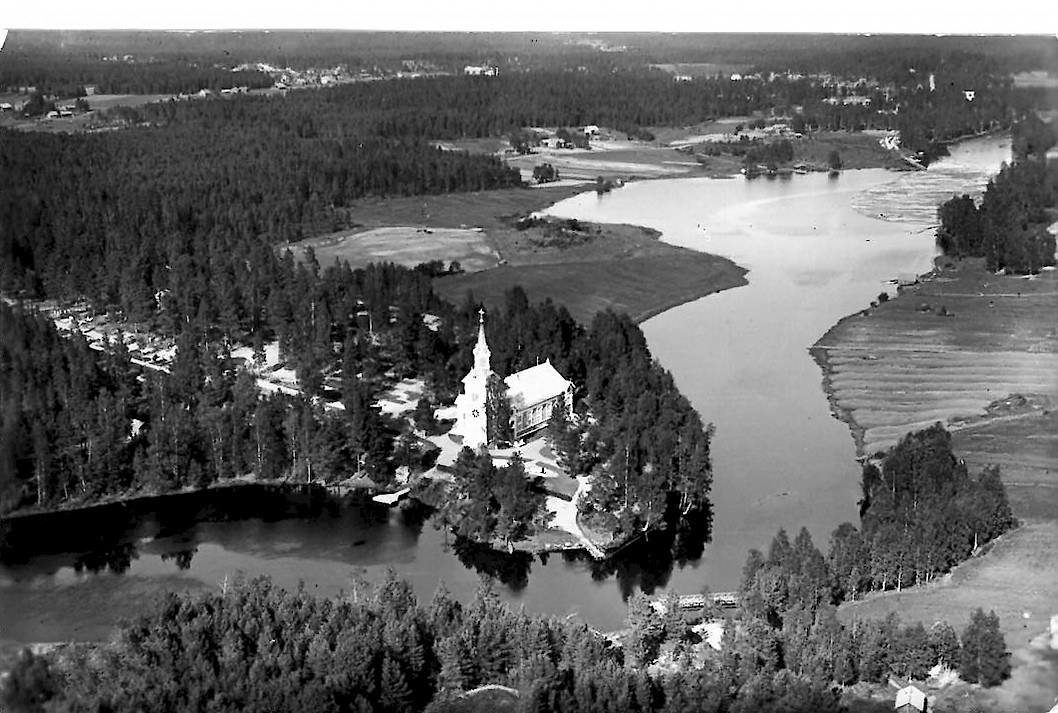
Picture from Vilppula-Seura ry.
1918
In 1918, Finland experienced a brutal civil war, which lasted for four months and resulted in the loss of nearly 40,000 lives. For seven weeks from the first days of the war, Vilppula was the centre of events. The northern side of Vilppulankoski was held by the White Guard and the southern side by the Red Guard. The Finnish Civil War ended on 16 May 1918 with the victory of the White Guard and the defeat of the Red Guard. The White Guard was led by the Finnish Senate and the Red Guard by the Finnish People’s Delegation that opposed the Senate.
During the first Red offensive against Vilppula, on 2 February 1918, the church and the area around it remained intact. On the following day, the Whites pulled the turn bridge onto the northern side of the rapids, with the aim of stopping the Red Guard from advancing across the strait. The White Guard also dug fire trenches to support their defense positions around the church. During the second offensive, on 4 February 1918, troops consisting of Red Guard and Russian fighters attempted to advance through the cemetery to strike at the flanks of the White Guard. The Whites responded by firing at the attackers from the firing line and with the machine gun placed next to the church. By nightfall, the Reds withdrew back to Lyly.
During the third offensive of 7 February 1918, the White Guard machine gun was place in the bell tower. This had already been attempted before, unsuccessfully. On the same day, the Reds attacked the church. Owing to the heavy fire from the attackers, the machine gun had to be taken down from the bell tower.
For the third time, the Red offensive was fought back by the rifle and machine gun fire by the Whites, as well as the supporting artillery fire from the two guns located in the centre of Vilppula. The Red artillery also targetted the church. The church was hit several times, mostly in the bell tower. One hit made the organ play by itself, creating an eerie atmosphere on the battle field. After 7 February, the church was never again the target of military operations.
